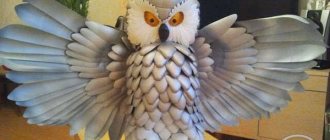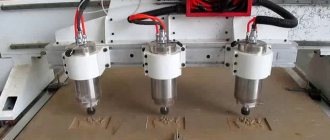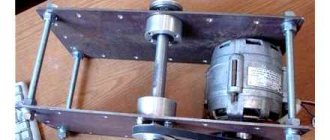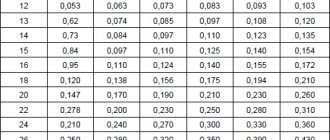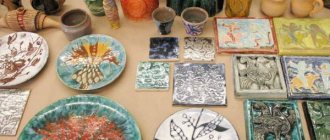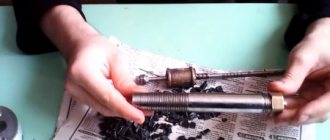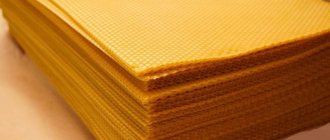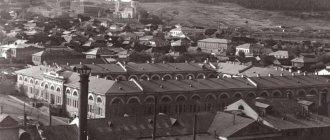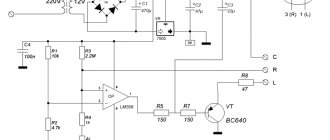Woodworking machines, DIY machines, Universal machines, Milling machines
Wood is one of the main materials that people use in everyday life to make furniture, interior decoration, decorative architectural elements, household and garden supplies and much more.
Wood copying machine.
One or two things can be done with hand tools or using woodworking equipment.
But how to process a large number of completely identical products with the least amount of labor and time? In this case, copying machines will come to the rescue. One of them is a copy-milling machine for wood.
The article discusses its structure and principle of operation, and also offers some advice to those who want to make the device themselves.
Basics of the Milling Process
In almost all large industrial production and small workshops you can find milling machines. After all, milling is the most popular method of mechanical processing of products. Milling devices are used to perform rough, semi-finishing and finishing machining of workpieces made of wood, ferrous and non-ferrous metals, as well as plastic. Modern machines are capable of quickly and accurately processing products of not only simple, but also the most complex shapes.
Milling machines are divided into two types:
- General purpose machines.
- Specialized equipment.
The specialized equipment includes the copy milling cutters in question. They allow you to make copies of objects and work with both flat and three-dimensional shapes. Moreover, these devices can help to engrave, apply ornaments, various inscriptions, and create various patterns on edges that are located in different planes.
There are two milling methods:
- Counter, in which the tool is fed and rotated in different directions.
- Incidental. In this case, the feed and rotation of the tool occur in different directions.
The cutting blade of cutters of such machines can be made of a variety of materials, which allows you to successfully switch from processing wooden products to hard metals and even natural or artificial stones.
This is interesting: How to make a cold forging machine
Features of the unit
A milling machine for metal or wood works using the following rules:
- The cutting element in this type of equipment is a milling cutter. It creates the desired contour or volumetric elements in accordance with the established software specifications;
- There is another connecting element between the cutting element and the tracking device. This is a supply and control system, which can be mechanical (used in the simplest units that process wood), hydraulic or pneumatic;
- As a copier, a specially created template, outline drawing or a ready-made part is mainly used. CNC copy-milling machines do not require such samples, so they are considered universal. These units operate thanks to numerical commands that are specified by the user through a special interface.
- templates can be blanks made from any materials - wood, metal, plastic, etc.
Work principles
The common element for all copy routers for wood or metal is the milling cutter - a cutting and processing tool.
Key points of operation of the milling device:
Using a copier, a surface or contour is specified, which is then followed by a cutter.- Between the tracking unit and the cutting cutter there is a system connecting them. When processing wooden products, it most often has mechanical control and feed. In addition to the mechanical system, a pneumatic or hydraulic system is used.
- The copier can be either a flat template, or a reference volumetric blank, a photocell or a drawing. CNC is built into complex machines, and then they become widely universal.
- The parts that act as templates can be made from anything. It can be wood, metal, plastic or other dense material.
All copying machines operate on the same principle: a tracking device is connected to a sample of any type, which, through a connecting system, transmits the necessary direction and force to the cutting unit - the milling cutter.
The use of a sample template eliminates manual intervention and therefore, even when making copies of complex parts, all resulting products are the same in shape and size. Copy milling can be contour, volumetric or direct. The workpiece being processed and the initial template are fixed on the moving working surface of the machine.
When contour copying, the working surface moves in the longitudinal direction. In the second case, during volumetric copying, the table with the copier and the workpiece are movable in both the transverse and longitudinal directions.
The unit between the copier and the cutter, which precisely sets the movement and force of the cutting tool, is called a pantograph. On wood or other materials, pantographs work equally flawlessly.
The pantograph is used in direct action machines. This unit allows you to organize not only copying, but also scaling of parts. Often such machines are used for engraving work.
The pantograph consists of a guide pin, its axis, a separate axis of rotation and a tool spindle. The guide pin and the spindle are placed on one bar. The copying scale directly depends on the ratio of the spindle arms and the pin.
The finger moves along the contour of the original and sets in motion the rack, which rotates freely on an axis. Thus, the spindle located on the other side of the rack follows the movement of the finger.
The cutting edge is driven by a screw, a spool valve, a solenoid, and an electromagnetic clutch. A relay is used in the amplification device of a metal copy milling machine. It can be electromagnetic, hydraulic or electro-optical.
Rotation is transmitted from an electric motor using a chain and a hydraulic cylinder.
The transmission of torque can be multi-stage.
The quality of the part obtained by copying, namely roughness, dimensional and shape accuracy, directly depends on the speed of response and movement of the tracking device. Good results are considered: profile accuracy is two hundredths of a millimeter, and the roughness must correspond to the sixth number of generally accepted standards.
Do-it-yourself homemade lathe and copying machine with drawings
Buying an industrial copy lathe is not so cheap. Therefore, many craftsmen prefer to make it at home with their own hands. If you have certain knowledge and a drawing, this is not difficult to do. The capabilities of such equipment depend on the characteristics of the copier itself.
Required Tools
To make equipment, a turner will need the following tools:
- manual frezer;
- support made of plywood or metal;
- bolts;
- persistent bars;
- a pipe 2.5 cm in diameter to give direction for movement around the site.
The main tool when creating a copy lathe is a milling cutter.
Design elements
The main equipment spare parts that should be in a simple machine:
- bed;
- headstock and headstock;
- electric motor;
- master and slave centers;
- support for equipment.
The simplest model is made from a drill.
Manufacturing stages
The manufacturing algorithm for a turning unit is as follows:
- According to the finished drawing, it is necessary to manufacture the frame by welding. It must be reliable and withstand varying levels of vibration.
- Then install the electric motor. The optimal option is 200-250 W, rated at 1500 rpm.
- Attach the faceplate to the shaft.
This creates the basis of a standard machine. Then you should make the copier itself.
Creating a copier
Basic principles for making a copier that will help increase productivity when creating identical parts:
- you will need a hand router, and to install it, a plywood surface;
- holes should be made in the plywood platform to secure the bars;
- secure the bars with self-tapping screws;
- when making a copier, it is necessary to use a level, since even a small inaccuracy can lead to significant errors in the manufacture of the product;
- the platform must move without obstacles along the machine bed.
Installation of structural elements
After creating the copier, you need to install all the structural elements:
- Place the block horizontally and attach the template to it with self-tapping screws;
- The structure itself must be made in such a way that, if necessary, the copier can be tilted or moved aside and the machine can be used as standard turning equipment.
Horizontal block
This is an important element. The size of the block is ideally 3x7 cm. It is attached to vertical stands on a plywood platform using self-tapping screws.
Sample
The template is made from plywood. Attach it to the front of the beam. The upper platform must be checked for alignment with the axis directly on the template.
The edges must be treated with a sanding machine so that there are no nicks on them.
Veneered plywood
Copier for wood lathe with manual router
We suggest that you make your own copying device with minimal time investment; the machine can be put into “industrial production” of turned parts by the evening. The “cutting tool” will be a hand router; the technical characteristics of the parts being manufactured depend on the technical characteristics of the wood lathe. Despite the fact that the copier is made using plywood, it can produce up to hundreds of products from one copier, you will agree that this quantity is quite enough to fulfill most wholesale orders.
The device does not look exactly “attractive” from a design point of view, but we did not set such a task for ourselves. We tried to make our “equipment” as simple to manufacture and more or less reliable as possible. Which is what happened in the end. How is a copier made? Let's get to know him better.
| Homemade copier at work |
Copier device
An ordinary hand-held milling cutter is used for the cutting tool; the specific model does not matter. Place the router on the support platform, our platform dimensions are 500×200 mm, made of sheet plywood 12 millimeters thick. You can slightly increase or decrease the linear parameters of the site depending on the size of the hand cutter. On the site, make holes for the cutter to exit and holes for installing mounting bolts. In order to completely eliminate unauthorized spontaneous movements of the cutter during operation, we advise you to install additional stop bars around the perimeter on the site, secure the bars with self-tapping screws, the length of the screws is selected taking into account the thickness of the fixing bars.
The router must be installed between the stop bars, check the reliability of its fixation, any vibrations are completely eliminated. The far end of the platform should “ride” along the pipe the entire length of the wood lathe, we used a Ø 25 mm pipe, you can use other pipes for making. The main thing is that they can withstand the weight of the router without bending, that they are absolutely flat and have a perfectly smooth surface. Secure the ends of the pipe with two wooden blocks; in our case, 80x35 mm blocks were used. Screw the bars to the body of the lathe using metal screws; you do not have to cut threads for the bolts. If your machine design does not allow you to fasten the bars in this way, then solve this problem in your own way.
| Platform for the router |
Installation of the main structural elements of a homemade copier
Strong advice - do not rush during the manufacture of equipment; turned parts for a copier do not forgive even the slightest violations not only of technology, but also of the location of the working axes. It follows from this that the axis of the pipe along which the milling cutter will move must be perfectly parallel to the axis of rotation of the lathe. We naturally found that the axis of the pipe coincided with the axis of the machine, but this condition is not necessary. The main thing is that the cutting tool of the cutter in its lowest position coincides with the axis of the machine, and this parameter can be adjusted by the level of the copier.
The pipe is fixed in the blind holes of the bars; before fixing it, you need to put two bars on it, on which the bearing platform of the router will be installed. An important condition is that the bars for the platform should slide easily along the guide pipe, but wobbling is prohibited. Check this parameter and, if necessary, manually lap the pipe and bars. Then attach the router support pad to the bars and install the router on it. Check the smoothness of sliding again, making sure that there is no wobble at all. Don’t be afraid of such “strict” requirements for gliding quality. If you have a pipe with a normal surface and completely flat, then achieving smooth sliding is not difficult.
Installation of a horizontal bar
This is the second “working” element of a homemade copier; in terms of installation accuracy, you must comply with all the above requirements. The profile template of the parts is attached to the horizontal bar. A 70×30 mm block is quite suitable for manufacturing; it is attached with self-tapping screws to vertical wooden posts; fix the posts in any convenient way to the lathe bed. The upper edge of the horizontal bar must be parallel to the axis of the machine and be flush with it. If the copier becomes temporarily unnecessary, the block can be easily removed, the mounting platform for the router tilts to the rearmost position and the wood lathe can be used for its intended purpose.
| Horizontal block for fastening the template |
Attach a vertical stop to the working platform of the router; we made it from thin plywood; you can use more durable materials, even metal. This part will move along the copier during turning and set the spatial position of the cutter; fasten the copier as firmly as possible. There is a direct relationship in terms of thickness: the thinner it is, the more accurately the dimensions will be taken from the template. But there is another dependence - too thin a copier makes it difficult to move the device along the template, choose the golden mean. The height of the copier must be adjusted after the final assembly of the machine; during adjustment, all the listed conditions must be observed. One more thing. If you have a copier made of plywood, then you need to make it removable; this will allow you to quickly replace a worn-out copier with a new one while turning a large number of similar products.
| Copier stop |
How the template is made
There's nothing new here. Draw the outline of the part to be turned on a strip of plywood or OSB board, check all the dimensions again and carefully cut out using an electric jigsaw. The edges must be sanded to remove nicks and irregularities. Attach the template to the horizontal rail with self-tapping screws; when fixing, observe all installation dimensions.
| Pinned template |
Some features of turning
You will have to move the device only with two hands, otherwise it may jam on the pipe. Another problem is that the radii of curvature of turned parts are limited by the diameter of the cutter; this must be kept in mind when choosing the profile of turned parts. Practice shows the dependence of the feed rate on the diameter of the cutter: the smaller the diameter of the cutter, the less the feed should be and vice versa.
← Do-it-yourself corner pergola How to properly upholster interior walls with sheet plywood →
We recommend watching:
Plywood FC | 6mm | 1520 mm x 1520 mm | birch | construction | NS
500 rub
Plywood NEEDLES | 12mm | 1220 mm x 2440 mm | coniferous | grade SM | NSH(PRICE ON REQUEST)
RUB 1,550
Plywood FSF | 9mm | 1220 mm x 2440 mm | birch | construction | NS
RUB 1,350
Plywood FC | 4mm | 1520 mm x 1520 mm | birch | grade 4/4 | NS
380 rub.
Plywood FSF | 9mm | 1220 mm x 2440 mm | birch | grade 3/4 | Ш2
RUB 1,700
Plywood FC | 10mm | 1520 mm x 1520 mm | birch | grade 4/4 | NS
820 rub.
Plywood FSF | 4mm | 1220 mm x 2440 mm | birch | grade 2/3 | Ш2
900 rub.
Plywood FSF | 10mm | 1500 mm x 3000 mm | birch | grade 3/4 | Ш1
RUB 2,450
Plywood FC | 18mm | 1520 mm x 1520 mm | birch | grade 4/4 | NS
RUB 1,380
Plywood FC | 8mm | 1520 mm x 1520 mm | birch | grade 4/4 | NS
680 rub.
LAMINATED PLYWOOD FOF (CHINA) | 21mm | 1220 mm x 2440 mm | birch
RUB 2,600
Plywood FSF | 9mm | 1500 mm x 3000 mm | birch | grade 3/4 | Ш1
RUB 2,250
Plywood FSF | 18mm | 1500 mm x 3000 mm | birch | grade 3/4 | Ш1
RUB 3,600
Plywood FSF | 10mm | 1500 mm x 3000 mm | birch | construction | NS
RUB 1,750
Plywood LAMINATED FOF | 18mm | 1500 mm x 3000 mm | birch
RUB 4,800
Plywood FSF | 27mm | 1500 mm x 3000 mm | birch | construction | NS
RUB 4,900
Plywood FC | 4mm | 1520 mm x 1520 mm | birch | construction | NS
350 rub.
Plywood FSF | 6.5mm | 1220 mm x 2440 mm | birch | grade 3/4 | Ш2
1,200 rub.
Plywood FC | 18mm | 1520 mm x 1520 mm | birch | grade 2/3 | Ш2
RUB 1,700
Plywood FSF | 9mm | 1220 mm x 2440 mm | birch | grade 4/4 | NS
RUB 1,400
Comments
- Valery 12/07/2018, 16:17
Unfortunately, even though the design is called a copier, it produces distortions like other “radius” homemade products. The fact is that the radius of the tool (from the rotation pipe) is smaller than the radius of the stop. Hence the distortions. This will be especially noticeable on large part diameters. It would be more accurate to call the design a “multiplier” of identical parts. Because It is impossible to make an exact copy of an existing part here. The design itself is characterized by ideal simplicity, reliability and easy repeatability. My respect to the author. - Alexandra 25.03.2016, 08:09
I've seen everything, but this is a masterpiece. It's simple. Thanks for the idea.
Types of milling machines with copying function
Copying machines can have different drives. On this basis, this equipment is divided into:
- units where a pantograph is present. Allows you to copy at the desired scale. The equipment where the pantograph is installed can process parts in several directions. The design of this unit includes a spindle pin and an axis of rotation. The pantograph provides the required scale of processing due to a certain ratio of distances between these elements;
- copiers that are equipped with a working mechanism mounted on a rotary rack;
- devices with single or multiple spindles that have rotary tables of various sizes and shapes;
- units with different supply schemes - mechanical, hydraulic, electrical;
- photocopying installations.
Depending on the degree of automation of all operations and the method of fixation, this equipment can be:
- desktop, where the workpiece is secured mechanically;
- stationary, where parts are fixed using pneumatic clamps;
- stationary with pneumatic clamps and a three-spindle head.
Do-it-yourself copying machine for a router
Examples of manufacturers
Those who need a reliable machine for flat milling should pay attention to the products of the Italian company GRIGGIO. Machines of this brand have a relatively low price and are a good solution for creating shaped parts, skirting boards, and trims. With their help it is convenient to create facades of furniture panels and wooden doors.
The VFK-810 milling machine with a table rotation angle of 45 degrees is perfect for those who are interested in making furniture. Its distinctive feature is the high speed of rotation of the cutter (up to 20,000 rpm), which guarantees excellent surface quality of the finished product.
The Chinese MX 5068 unit has comparable characteristics at a much lower price. It boasts a cutter rotation speed of up to 18,000 rpm and uses a pneumatic drive for table rotation and tool movement.
Those who are planning to take up carpentry seriously should pay attention to a milling unit made in Taiwan. WINNER LH-1000 will be the best assistant when it is necessary to mass produce similar parts. A special feature of the machine is a multi-level spindle, which allows you to perform several operations at once in one pass and create a product of the required profile without the need to rearrange the cutting tool.
Homemade machine design
A DIY wood milling machine will consist of the following structural elements:
- work surface that fits in size;
- a supporting frame that will ensure the stability of the unit during operation;
- unit required for installing cutters.
When making this homemade product, you need to take into account that the milling head used must be equipped with a transmission mechanism, which must have an electric motor. This will provide the unit with several operating modes at different speeds.
Milling head
This is interesting: How to weld stainless steel using a homemade welding machine
What does a copy milling machine consist of?
A simple homemade wood copier
Nowadays, there are quite a lot of designs of home-made equipment for this purpose, depending on the drawing used and the tasks that will be performed on this equipment. A typical wood copier consists of the following basic elements:
- suitable sized work surface;
- supporting frame;
- device for installing the router.
The milling head must be equipped with a transmission mechanism with an electric motor, which can provide several operating speeds for a homemade wood milling and copying machine.
A large number of craftsmen who made such a machine with their own hands according to drawings note that as a result of copying, the finished part has a sufficient number of flaws. They appear during a change in the direction of operation of the cutter, trembling and vibration of the entire structure. In addition, inconsistencies also occur due to the curvature of the workpiece, which occurs when the internal stress increases as a result of the processing of the wooden workpiece.
It is almost impossible to eliminate the possibility of certain defects occurring in the process of manufacturing a homemade machine. To reduce them to a minimum, it is recommended to produce not universal, but narrow-profile machines with your own hands, on which it will be possible to produce and copy parts of one specific type.
General description of the equipment
The purpose of wood copying and milling machines is to process various parts both in volume and in plane. Their operating principle is somewhat similar to CNC units. If wood samples are processed, then using milling machines of this type the following can be achieved:
- reproduce any ornaments;
- apply the desired inscription to the surface of the workpiece;
- engrave shaped profiles;
- obtain complex volumetric workpieces with multiple small parts that are placed in different planes.
Processing parts on a machine
A milling and copying unit that works with wooden parts is most often used for furniture production. It helps to create all the necessary decorative elements, which is difficult to achieve in any other way.
Classification
The copier is used in lathes for wood and metal. It significantly simplifies the work on the template and speeds up production.
On wood
There are the following types of woodworking equipment with a copier:
- Classic, where a chisel is used as a cutting tool. Such machines are not suitable for large industrial production.
- Copiers with manual control type.
- Copy milling machine. It is used for processing flat and three-dimensional workpieces.
- Units with Numerical Program Control are used in mass production for the manufacture of expensive products.
Machines with a copier have an increased level of accuracy and performance in terms of technical characteristics.
For metal
For metal, the classification of lathes is similar. There are classic models where the workpiece is fixed in a faceplate or chuck and processed with a cutter. Copying machines are used to produce products in circulation.
Milling types of machines are used for processing flat surfaces and volumetric workpieces. CNC is used on an industrial scale.
Milling options
Milling on a copying machine can be carried out using one of two methods:
- Up milling , in which the part is fed in the opposite direction from the cutter.
- Climb milling , in which both the workpiece and the cutter move in the same direction.
Milling methods
The cutter on such devices can be made of mineral ceramics, synthetic or super-hard material and can replace the grinding procedure. But for machines working with wood products, this is not very important, since this material is not particularly hard.
Types of devices
Copying equipment may differ in drives, which come in different types.
Based on the drives, they are distinguished:
Devices that have a pantograph, which allows you to process parts in different dimensions.- Equipment in which the copier is mounted on a rotating bar that is movable vertically.
- Machines with rotary tables. The device may have one spindle or several. The table has a round or rectangular shape.
- Photocopiers.
- Equipment with feeding due to mechanical, hydraulic or electrical components.
The machines also differ in the degree of automation and options for fixing workpieces.
Based on this device there are:
Tabletop or handheld. The workpiece is fixed mechanically. This method allows you to drill holes on a workpiece according to a given pattern.- Automatic machines on which workpieces are fixed with pneumatic clamps. These machines are stationary and work with aluminum.
- Automatic stationary units with pneumatic springs and a three-spindle head. With this design, it is possible to simultaneously drill triple holes, which is impossible to do with previous types of devices.
On the modern market there are many offers for ready-made machines of various levels and complexity. But some craftsmen prefer to make homemade copy milling machines for wood or metal. If there are drawings, tools and source material, then such equipment is not difficult to assemble.
What is copy-milling equipment
The pantograph is the most important element of the machine.
This equipment is unique because... with its relatively simple design, it is capable of copying complex products, even fine handmade ones.
In fact, the unit was designed for milling curved elements:
Note! The instructions recommend equipping it with a special copying device for this purpose. It is called a “pantograph” and serves to accurately communicate the movement of the copying unit (head) to the main device that processes the part.
When a template has many fine, elegant details, a pantograph machine is indispensable.
Unit design
The photo shows a desktop device with mechanical clamps.
Copy-milling units make it possible to process reliefs or profiles:
Note! The pantograph plays a vital role in the described units. It is equipped with a special guide “finger”.
It moves along the copier, while determining the geometric parameters of the sample with maximum accuracy. The final size of the resulting copy depends on the proportions of the pantograph’s “shoulders.”
Duplicarver machine
The units of this brand are of the highest quality.
The most popular brand of copy milling machines are the Duplicarver units:
The executive unit of the device, consisting of an electric motor and a cutter.
Features of operation and safety precautions
The operating principle of copying and turning equipment is simple:
- the blank of the future product is clamped in a horizontal position;
- the machine is started, which rotates the workpiece around an axis;
- the cutter removes excess wood from the workpiece, giving it the required shape.
To avoid injury during work, you must follow basic safety rules:
- Do not expose or remove the workpiece from operating equipment.
- Do not lean or press against the machine while working.
- Remove chips only with a special brush.
- The machine must not be left unattended during operation.
- The technician must wear safety glasses to prevent chips from getting into his eyes.
A turning unit with a copier is successfully used both in large mass production and in home workshops for the manufacture of identical products. You can make such a machine yourself, having an unnecessary hand router, a sheet of plywood and horizontal bars of a certain size.
Main advantages of turning tools with indexable inserts
Features of metal processing by rolling on a lathe
DIY making
A homemade wood carving copying machine, of course, cannot fully compete with industrial designs.
When using homemade devices, various disadvantages are observed. The most common problems are vibration of the machine frame, sagging of the workpiece, and large errors when copying. Therefore, when designing your own machine, you should take into account the tasks that it will solve. It is easier to assemble a narrow-profile device than a universal one, immediately setting it up to solve the same type of problem.
Despite the variety of diagrams showing the order of assembly of the machine, all devices have the same basic components.
The minimum set of elements is as follows:
- Working desk.
- Bearing frame.
- Milling head.
Rotation from the electric motor is transmitted through the drive to the head with the cutter. If it is necessary to change the cutting mode, the height of the table changes. If desired, a transmission mechanism is developed to change speeds.
The pantograph can be assembled from wood or metal.
The wood pantograph has its drawback, since the wooden parts are connected using hinges and, thus, they are characterized by backlash. Therefore, the processing accuracy of a wooden pantograph is low.
When making a metal pantograph, it becomes possible to create copies of different scales. But he doesn't know how to make large copies.
Some craftsmen are trying to remake an ordinary production milling machine by adding a copying device to it. In this case, it is necessary to remake almost the entire old machine and it is easier to assemble the unit from scratch.
The size of the workpieces that the machine will have to process should be taken into account. The greater the length of the workpiece, the greater the load on the guide axis of the machine. They may not be able to withstand such a load. And also when working with large parts, the tool experiences large vibrations. To compensate for the moment of vibration, the equipment must be designed massive and heavy.
Therefore, first of all, before creating a copy milling machine for metal or wood, you need to highlight the tasks that will be solved when working on it. Based on this, the dimensions of the table and the entire structure, methods of attaching the template and options for moving the cutter are planned.
If you plan to process flat parts, then two machine axes will be enough for contour copying, since the movement will only be longitudinal and transverse.
If you expect to work with embossed workpieces, you will need to add a perpendicular movement.
If the relief is large, then you have to rely on one more axis - the fourth.
All possible options must be thought through before starting production of the machine, since after manufacturing and assembling all the components, it is very difficult to make changes to the existing design.
The layout of the machine can be horizontal or vertical. If the machine is vertical, then during milling the chips fall either onto the table or into a special tray, and do not settle in the parts of the cutter.
For better quality of product processing, the milling head must be high-speed.
To process parts made of different materials, it is advisable to have a set of cutting cutters of different quality and wear resistance.
After determining the range of tasks, the required motor power is calculated. To perform engraving and similar work on wood, a motor with a power of one hundred and fifty to two hundred watts is sufficient.
The working unit and the probe are fixed together so that they are on the same plane and height in relation to the working table. A rigid clamp is used as fastening. Then the entire assembled element will be able to move parallel to the sides of the working surface, both horizontally and vertically.
All moving parts must be as light as possible so that control forces are minimal.
Duplicarver for wood with your own hands drawings
Very often in our lives there is a need to make a copy of some object, so the availability of copying equipment is a modern need for many enterprises. And we will not be talking about copy printing equipment, but about copy milling machines.
Copy milling machine
They serve to create objects that closely replicate the original design. The equipment makes it possible to produce parts in large quantities, ensuring high processing speed.
1 Features of milling
Milling is one of the methods of mechanical processing. The procedure allows for finishing, roughing and semi-finishing of various surfaces of workpieces made of wood, plastic, cast iron, metal (ferrous and non-ferrous).
Milling has high productivity, making it possible to create objects of the required geometric shape.
Milling can be organized in two ways:
- down milling, in which the directions of feed and rotation of the cutter coincide;
- up milling, in which the feed is opposite to the direction of rotation of the cutter.
Using cutters equipped with modern cutting materials, it is possible to carry out processing, replacing the grinding procedure.
Copy-milling machine Duplicarver
A woodworking milling machine, including a mini modification, is used for processing the surfaces of planks, levers, covers, cases and brackets of simple configuration, and the surfaces of cabinet objects.
Allows you to apply 3D or 4D carvings. One of the most popular brands of domestic origin is Duplicarver.
Milling machines come in two categories:
- specialized;
- general purpose.
The last group is continuous milling equipment, non-cantilever, cantilever, longitudinal milling. The first group is copy-milling, key-milling, slot-milling, gear-milling, thread-milling. There are full and mini models.
1.1 Purpose of the machine
A copy milling woodworking machine is used to carry out copying work on a plane and in volume, to engrave patterns, inscriptions, ornaments, shaped profiles, as well as to implement simple milling tasks.
Automatic double-sided copy-milling machine Valestrini
Despite the simplicity of the machine, it allows you to create incredibly complex patterns. It can be mini or full-size.
The equipment allows you to perform various milling operations using carbide and high-speed tools. Can make threads. The machines are used in small and large-scale production. They can work in 3D mode, if the appropriate equipment is available, CNC. Duplicarver models are very popular.
The machine allows you to create:
- blanks and models;
- Press forms;
- various stamps;
- cams;
- forms.
The process of duplicating products on a milling machine
The equipment can also be used for:
- drilling holes for metal hinges, handles, latches, locks;
- production of frames for mirrors;
- channels of different sizes on profiles.
The Duplicarver wood milling machine allows you to mill curved parts by copying a template from which the shape of the future product is copied. Thanks to the use of templates, the influence of the so-called human factor is eliminated, so the finished products have an identical shape. This is largely ensured by CNC.
Not only a template sample can be used in the work; subsequent products can be made according to the sample of the first one. To increase accuracy, the machine should be supplemented with a copying device called a pantograph.
It may have a different design, but it has an important function - accurate transmission along the profile of the movement of the copy head to the cutting device. Therefore, high precision of the thread is achieved when applying it.
2 Machine design
The Duplicarver milling machine uses a carbide cutting tool – a milling cutter. It reproduces the surface or contour of the copier on the product.
Wood turning and milling machine with copier TFS-1550
This machine master device has a hydraulic, mechanical and pneumatic connection with a tracking system responsible for the direction of the cutter. On the one hand, it acts on the amplification device, on the other, it affects the executive body.
The copier is a flat template, outline drawing, reference part, spatial model. Copier - photocell, finger, roller or probe. Samples can be parts made of wood, plastic or metal. The copier and the workpiece being processed are located on a rotating table.
The executive body of the Duplicarver machine is a differential, electromagnetic clutch, solenoid, screw, spool. Electro-optical, hydraulic or electromagnetic relays can be used in amplifying devices.
The speed of movement of the tracking device determines the accuracy of the profile and the surface roughness of the product. An accuracy of 0.02 mm and a roughness of No. 6 can be achieved. The Duplicarver machine is driven by an electric motor and a power hydraulic cylinder.
What is the milling process?
Copy-milling machines and any other equipment of the milling group can be found in almost any industrial enterprise. This is explained by the fact that the milling operation is one of the most common methods used to perform machining. This technology allows you to perform a wide range of roughing, semi-finishing and finishing operations with simple and shaped workpieces made of ferrous and non-ferrous metals, and to work on wood and plastic. Modern milling equipment can process parts of even the most complex shapes with high precision and productivity.
» data-lazy-type=»iframe» src=»data:image/gif;base64,R0lGODlhAQABAIAAAAAAAP///yH5BAEAAAAALAAAAAABAAEAAAIBRAA7″>
There are two main types of milling: counter (feed and rotation of the tool are in different directions) and down milling (the tool rotates in the same direction as the feed). The cutting part of the tools that perform milling is made of various materials, which makes it possible not only to successfully work on wood, but also to process (including grinding) even the hardest metals and alloys, artificial and natural stone.
Milling equipment is divided into two types: general purpose and specialized, which includes a copy-milling machine.
Features of creating a copier yourself
Milling and copying machine for making the wooden part of a gun
Thus, when making copy-milling machines with your own hands, it is necessary to optimize them for processing specific parts that will be produced on it. Otherwise, various side effects may occur, which are often very difficult to correct.
A fairly important factor that must be taken into account when making a copier machine yourself is its size and total weight. The larger the products will be processed on it, the more massive the entire structure should be. This will enable the equipment to absorb vibrations that arise during the operation of the cutter. The guide axles must be made so that they have a significant margin of strength without bending under increased loads.
The optimal properties of a copy-milling machine for wood when making it yourself can be selected experimentally, since this depends on the design of the equipment and the purposes for which it will be used.
What should be considered when designing a machine?
When creating a drawing of a wood copying machine and designing it, you need to do everything depending on the parts that will be made on it. So, in order to mill long workpieces or perform engraving work, a completely different method of securing the workpieces and the type of work table are required.
Also, the power of the electric motor required for high-quality work, which ensures the rotation of the cutter, depends on the parts manufactured and copied on the machine. But in most cases, a 150-220 W DC motor is sufficient for processing wood parts.
To ensure maximum accuracy of copying parts, the device holding the router and the copying probe must be secured to each other as firmly as possible. At the same time, their planes, together with the height above the working surface, must coincide completely.
The created rigid structure must be installed on the table surface in such a way that it is able to move in horizontal and vertical planes.
Thus, it is not very difficult to make a copying machine yourself for making various parts from wood, so many people can cope with such work. But you need to remember that if you make such equipment yourself, it will only be suitable for the production of products of a certain type. Otherwise, only modern universal factory-made equipment will do.
Recommendations for creating a machine
When making a copy-milling machine for wood with your own hands, you need to create a drawing and design all the parts in such a way that in the future it will be convenient to work with workpieces of the selected size. For example, there are two types of work - milling long workpieces or engraving. These two operations require that the method of fastening the workpiece, as well as the work surface, be completely different.
This is not the only reason why you need to think things through in advance. The second thing that anyone who creates a machine on their own will have to face is the choice of an electric motor. Depending on the density of the material with which you will need to work, it is necessary to select the power of this product. If we talk about working with wood, then most often a motor with a power of 150 to 220 W is enough.
Another feature that must be observed is the most durable fastening of the copy probe and the device that holds the cutter. These two small details are very important, since the accuracy with which the machine can reproduce the model from the sample will depend on this.
Pantograph for a router: materials
In order to make a pantograph with your own hands, you will need the following materials:
- Square metal profile 12×12
- Bearing 180201.
- Bushings for the outer race of the bearing.
- Pins according to the internal size of the bearing and M12 thread.
- Nut M12.
- Bolts M6×45
- Nuts M6.
- Bushing for securing the copier.
- Profile pipe 40×40
- Hinge of a metal-plastic window.
- Dye.
- Masking tape.
- Metal plate.
- Screw for fixing the copier.
The process of creating a machine with your own hands
Drawings of a homemade mini wood milling machine
Buying a copy-milling machine for wood, especially one equipped with CNC, is beneficial for large manufacturers; in other cases, it is easier to create it yourself.
Before manufacturing a machine, it is necessary to create a drawing and decide how the device will be used. If you plan to work with large products, then the size of the machine should also be large so that the cutter produces less vibration. In addition, you need to select an electric motor of sufficient power. The choice depends on the density of the material you plan to work with.
The number of axes is also determined at the layout stage, since changing the design of a finished machine can be problematic. To work with flat parts, two axes are sufficient: with longitudinal and transverse movement. Workpieces with slight relief also require a perpendicularly moving axis. For more complex products, four or five axes may be needed.
There are many milling machine designs, but they all consist of three elements:
Copy milling machine - device
- working surface;
- bed;
- milling head.
The design of the working surface of the copying machine must provide for height adjustment, and the milling head must be high-speed and equipped with an electric drive.
The layout of a wood copy-milling machine can be vertical or horizontal. The comfort of working with the tool and unloading finished parts depends on this.
Pantograph
Homemade pantograph - drawing
The cheapest option, for the manufacture of which you need several boards and a router. Designed for flat threads.
The shape resembles a parallelogram. Thanks to this design, when moving, nodal points describe equidistant curves. To scale the device, the link is lengthened.
The side of the parallelogram is half as long as the total length with the copying tip. Because of this feature, when copying any part with the tip, the cutter will halve it, which reduces the copier error.
Model with plane-parallel mechanism
Used for contour milling. Unlike the previous model, a curved trajectory is achieved by adding two axes perpendicular to each other. The third axis inserts the cutter into the workpiece.
To balance the system, the design includes a counterweight on the other side of the swing frame. To be able to adjust, it is better to place it on a threaded rod.
Copy milling machine with plane-parallel mechanism
Model for volumetric milling
On such a device, the milling head is placed on a swinging frame, which during processing moves on roller carriages along perpendicular guides. The model and the part are mounted on two rotating units at the bottom of the base. The open frame makes it easy to clean out sawdust.
Copy milling machine for volumetric milling
Duplicarver-2
Serial copy-milling machine for wood, designed for both flat-relief and sculptural carving. The design provides five controlled axes:
- side arms;
- rotating frame;
- milling head;
- work tables;
- lateral movement of the head.
Quite light (weight about 28 kg) for one person.
Duplicarver-2
Design features of the machine
In order to understand how to make a copy-milling machine for wood, you should become more familiar with its design features. Such installations are designed for processing profiles or reliefs of products using a carbide cutting tool called a milling cutter. It forms a contour or repeats the surface of the master unit - the copier. It has a mechanical, pneumatic or hydraulic connection with a tracking system responsible for guiding the cutting part.
On the one hand, the effect is on the amplification device, while on the other, on the executive body. When making a copy-milling machine for wood, you can use a flat template, a reference part, or a spatial model as a copier.
The copying device will be a probe, finger, copy roller or photocell. You can make samples for copying from different materials, namely:
- wood;
- plastics;
- metal
When manufacturing a copy-milling machine for wood, the copier and the workpiece are fixed on a rotating table. As for the executive body, it is a differential, electromagnetic clutch, solenoid, screw or spool. If we are talking about a machine with an amplifying device, then the design involves the use of hydraulic, electromagnetic or electro-optical relays.
The accuracy of the profile and the surface roughness of the product will depend on the speed of movement of the tracking unit. The actuator circuit is driven by an electric motor and a hydraulic power cylinder. A wood copying and milling machine will have a pantograph, which is a special device that ensures copying at a specified scale.
If you plan to manufacture the machine yourself, then this unit can be included in the design. It has a guide pin located on the axis. Its movement is directed towards the copier. As the finger moves, the spindle describes a similar geometric figure on the workpiece. The copying scale will be determined by the proportions of the pantograph arms.
